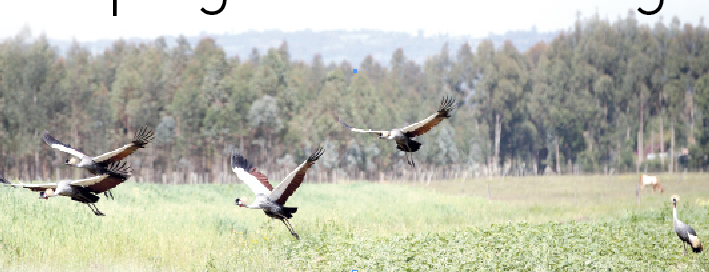Keeping cranes soaring
By Harriet James, October 29, 2019For many, the grey crowned crane is synonymous with Uganda— it is the country’s national bird and is the central feature of its flag. These birds, endemic to sub-Saharan Africa, call Uganda and Kenya home but now concerns have been raised over their dwindling numbers.
For the last 45 years, the population of the cranes has gone down by 80 per cent. This means where there were once 100 birds, only 20 remain today. A 1988 survey carried out in East Africa indicated Kenya had 35,000 grey-crested cranes, but the numbers reduced to 12,500 as of 2015. Last year’s census showed a further decline, with numbers currently at between 8,000 to 10,000.
Only two birds
“A lot of the extinction comes from human activities; not natural causes,” explains George Mungai, founder of the Cranes Conservation Volunteers at Lake Ol Bolossat, where extensive efforts have been initiated to conserve the birds, known for their beauty and mythical significance.
Fishing, grazing and construction of houses along the lake have resulted in the decline of the birds and animals such as antelopes, zebras and gazelles.
Mungai, who studied ornithology at the National Museum of Kenya, discovered how endangered these bird are. Globally, there are only 15 cranes species, with only two featuring crowns and residing in Africa: the black crowned crane traced in Lake Turkana, but presently in Ethiopia and the grey crowned crane found in East Africa.
Mungai’s trip to Burundi triggered his interest in ensuring this species is preserved in his hometown. “There were only two grey crowned crane birds in the whole country. I said to myself, if we don’t do anything to save them in Kenya, the same thing will happen,” he narrates.
Together with some volunteers, they searched for the birds’ nests and discovered residents would catch and eat the birds and their eggs, one of which is equivalent in size to three chicken eggs.
Their suitable breeding season starts from July to February. Lake Ol Bolossat is a favourite hatching ground as its water facilitates the growth of vegetation required for breeding. Cranes sit on the eggs for 48 days and when they hatch, the offspring take between 11 to 12 weeks before they attempt fledgling (flying), a period within which they face the most danger.
“Cows would crush the eggs inside the wetlands or floating marshes. Children who come out to play, crush the eggs or take hatchings home for domestication. However, with sensitisation in schools and churches and engaging the local community, this practice is slowly dying,” he adds.
The Kenya Wildlife and Management Act 2013 stipulates that any person who causes harm or threat to any endangered species faces a fine of Sh20 million, life imprisonment or both. Since the cranes are endangered, conservationists have taken the diplomacy path of sensitising locals in vernacular.
“Some parents admitted their children came home with the eggs, giving us the opportunity to educate them. It was hard to reach out to the youth, but we have turned to sports to entice them,” Mungai adds. They met one group called Black Mamba and engaged them on conserving the birds in 2018.
Sports for conservation
Football is one of the ways to hold tournaments between teams with players aged 15-28 years from nearby villages. The winning team receives balls, kits and shoes to enable them pursue their passion in the game and motivate them to engage in conservation.
Werner Schroder of Nature and Biodiversity Conservation Union (Nabu) in Germany, says environmental education is vital in ensuring the locals take care of the cranes. In partnership with Nature Kenya and the cranes conservation group in Nyahururu, they reached out to the youths through football to sensitise the group on the value of conservation.
“In 2017-2018, 56 chicks were able to fledge (fly) because of reduction of egg collection. In 2018-2019, about 84 chicks have fledged. There is no other place in Africa where such conservation has taken place like it has in Kenya,” Schroder says. The organisation is active in Rwanda, Ethiopia, Kenya and Tanzania where the cranes are.
Part of their work is carrying out research on the behavioural patterns of the cranes to know key sites to focus on, as the Lake Ol Bolossat is not their permanent residence. Using tagging and GPS transmitters, researchers indicates that while cranes come to the lake for breeding, they sometimes travel all the way to Nanyuki, Samburu, Meru or even Uasin Gishu.
“We desire to start conservation in those areas too, so that the work we have started doesn’t go to waste,” says Mungai.
